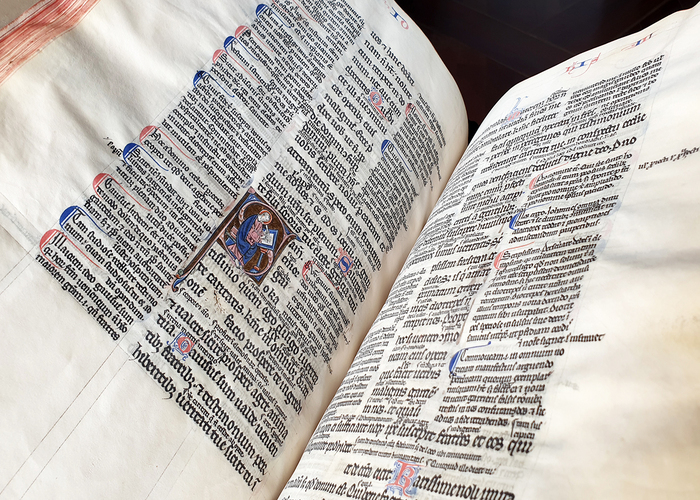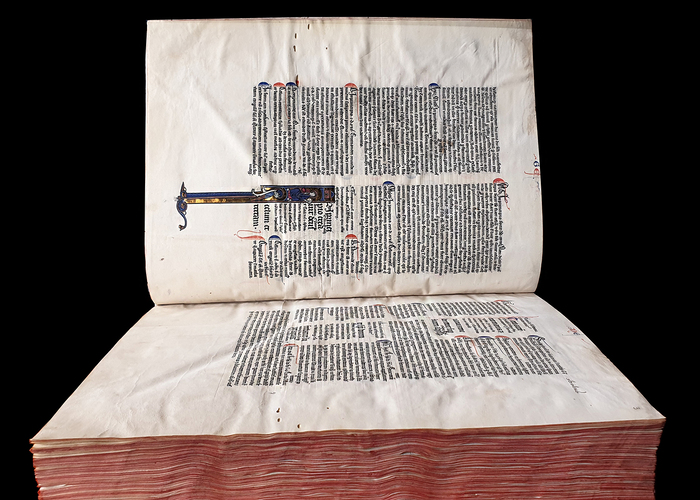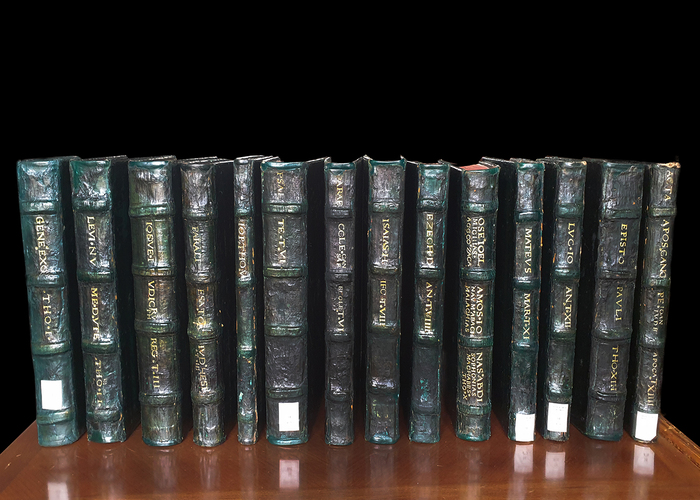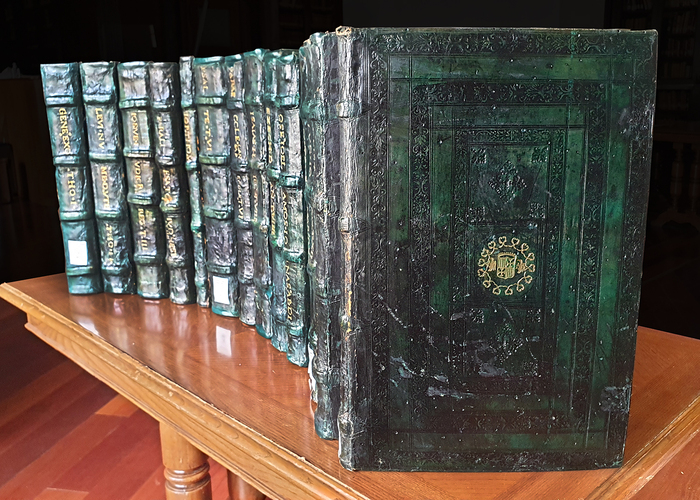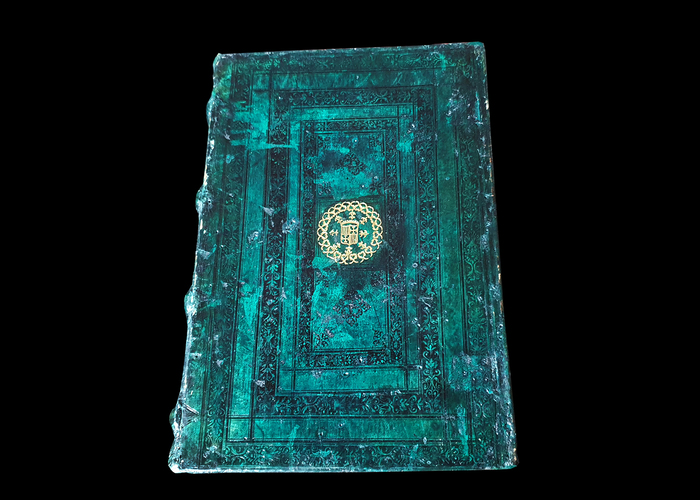
The Manuscripts Working Group (made up of Francisco M. Gimeno Blay, Professor of Paleography and Diplomatics, academic head of cataloging, and Silvia Villaplana Traver, librarian of the Biblioteca Històrica) has completed the description of fourteen volumes, in which the It transcribes a singular work conserved in the Biblioteca Històrica of the Universitat de València: the Glossa ordinaria in Bibliam.
It is a handwritten edition from the first half of the 14th century from a French scriptorium, which includes miniated initials with biblical scenes or decorated with anthropomorphic and zoomorphic motifs.
This work contains the full text of the books of the Latin Vulgate, accompanied by the corresponding gloss. Most of these comments come from the works of the Church Fathers (Saint Augustine, Saint Jerome, and Saint Bede the Venerable, among others). All of them are arranged in the form of marginal and interlinear glosses. In the composition of each page, a hierarchical structure is established between the texts gathered there. The biblical text stands out for presenting a module writing greater than that of the comments, which are located around it or between the lines of the text. Sometimes the names of the Fathers of the Church are mentioned, attributing to them the authorship of the comments. The page layout used is intended to guide the reading of biblical texts and their glosses.
The catalogued edition consists of fourteen volumes, corresponding to manuscripts 463 to 476 of the Library. The biblical text and the comments are distributed as follows:
- ms 463: Genesis, Exodus
- ms 464: Leviticus, Numbers, Deuteronomy
- ms 465: Joshua, Judges, Ruth, 1-2 Samuel, 3-4 Kings
- ms 466: Job
- ms 467: 1-2 Chronicles, Ezra, Nehemiah, Tobit, Judith, Esther
- ms 468: Psalms
- ms 469: Proverbs, Ecclesiastes, Song of Solomon, Wisdom of Solomon, Ecclesiasticus
- ms 470: Isaiah, Jeremiah, Lamentations
- ms 471: Ezekiel, Daniel
- ms 472: Minor Propeths (Hosea, Joel, Amos, Obadiah, Jonah, Micah, Nahum, Habakkuc, Zephaniah, Haggai, Zechariah, Malachi), 1-2 Maccabees
- ms 473: Gospel of Matthew and Mark
- ms 474: Gospel of Luke and John
- ms 475: Epistles of Paul (Romans, 1-2 Corinthians, Galatians, Ephesians, Philippians, Colossians, 1-2 Thessalonians, 1-2 Timothy, Titus, Philemon, Hebrews)
- 476: Acts of the Apostles, Catholic Epistles (James, 1-2 Peter, 1-3 John, Jude) and Apocalypse
The description has made it possible to identify the bibliographic collections of which it has been a part. The Ordinary Gloss was incorporated into the Universitat de València in 1837, coming from the monastery of Sant Miquel dels Reis, as indicated by the note of possession located on the first pages of each of these manuscripts, and which reads: “Es de la Librería de San Miguel de los Reyes”. There the manuscripts went, ca. 1550, from the collection of books by Ferdinand, Duke of Calabria, as revealed by the heraldic shield on the front cover of all volumes. The Duke, in turn, received them together with other biblical and theological manuscripts from the Dominican convent, as revealed by the annotation at the end of ms 476 (f. 123v) that says: "Iste liber est conventus fratrum predicatorum Valencie".
Manuscript cataloguing, a complex activity
The working group in charge of cataloguing the manuscripts of the Universitat de València began to describe them systematically in 2011 within the framework of the Europeana Regia project. After the description of the codexs selected for that occasion, the team continues cataloguing the medieval and Renaissance manuscripts kept in the Biblioteca Històrica.
The preliminary analysis of each and every book studied involves a complex activity, given that there are many obstacles that must be overcome. These are books written in scripts that are far from the current ones, frequently in Latin and other Romance languages in a different state of evolution from the current one. Consequently, cataloguing requires cross-training and an auxiliary library that contains editions and critical studies on the authors whose texts are studied. The activity carried out requires, in short, a scholarly training.
Once the manuscripts have been studied, the working group completes the corresponding bibliographic record, which can be consulted in "Trobes". Right there, in "Somni", the reader can find the link to view the digitized version of the manuscript. This is the commitment made by the work team: to make available to the scientific community a description of the manuscripts as rich and complete as possible.
Images:
.jpg)

